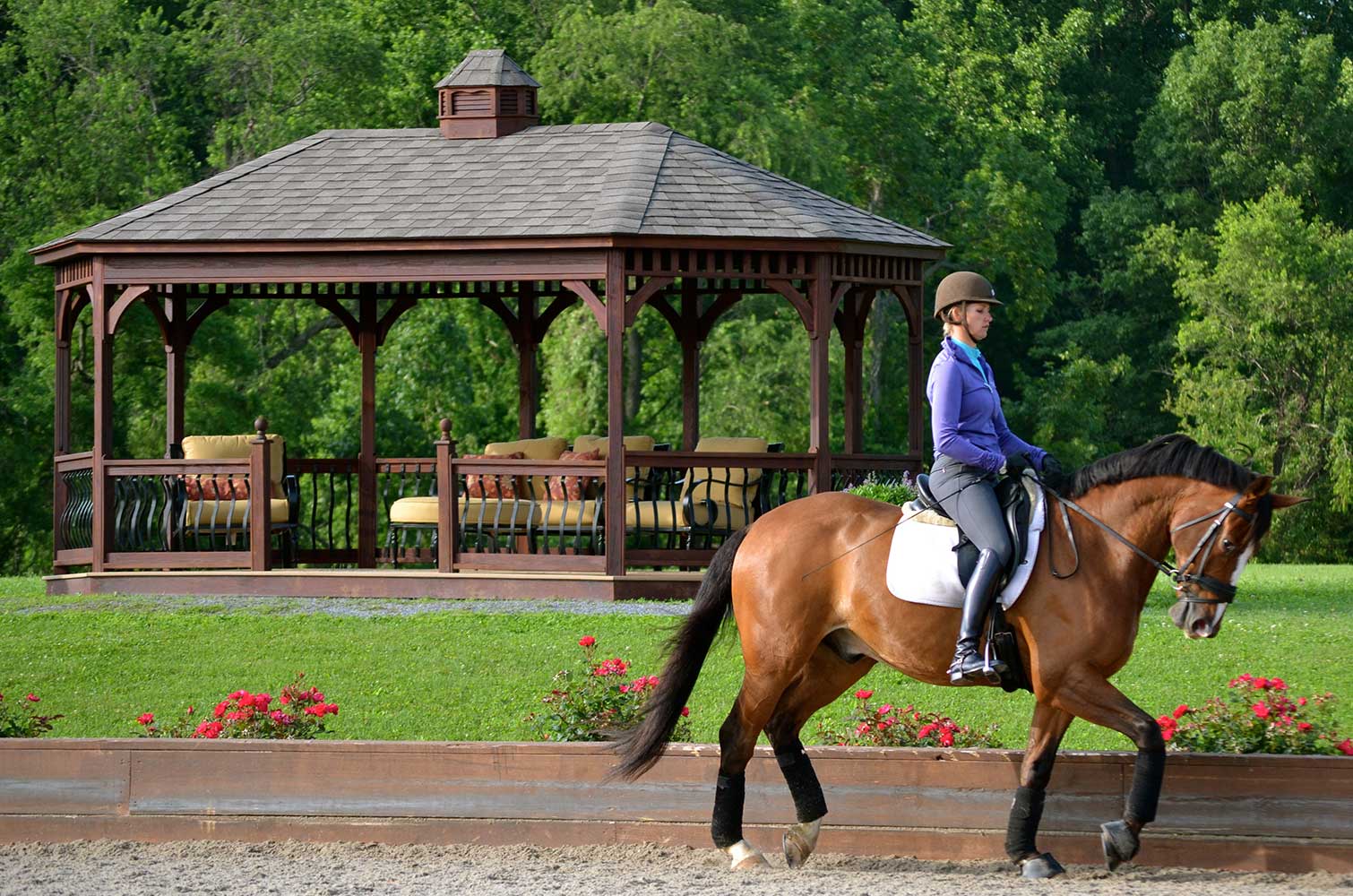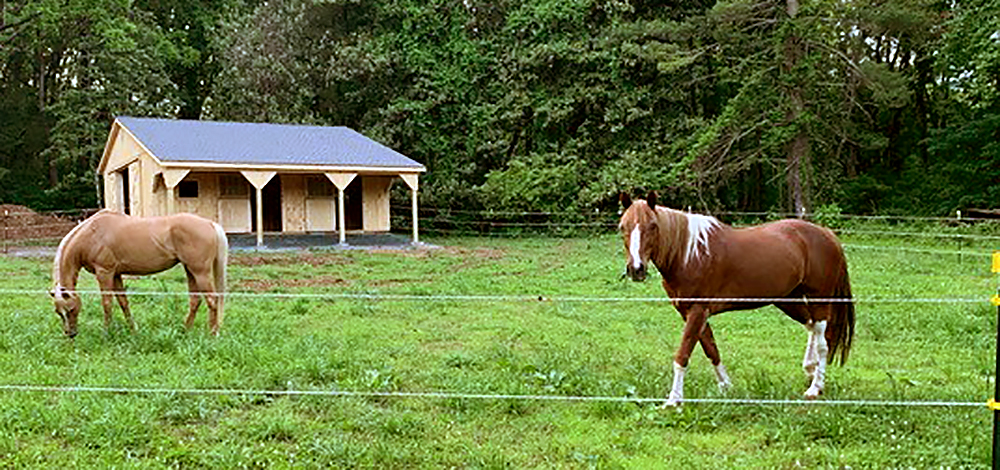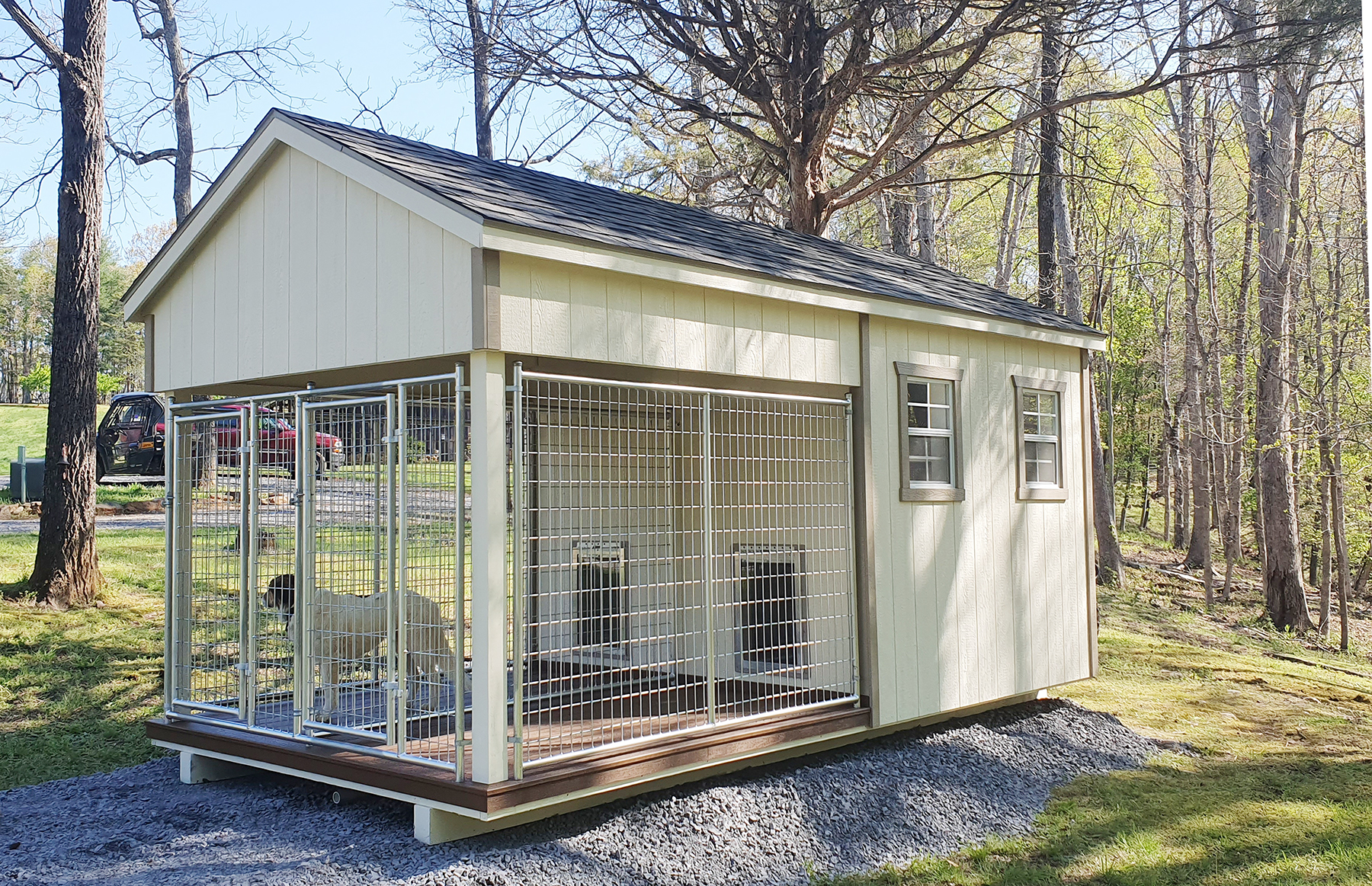
by Nikki Alvin-Smith
The bountiful benefits of the sun’s rays bring joy to the hearts of horses and humans, especially for the winter weary residents of colder climes.
But the sun is not good for everyone. Staying sheltered out of the heat and burning beams can be especially important for creatures great and small, especially the young, the elderly, the fair-skinned and the cancer prone. Here are some shade ideas that offer an economic method to address the issue of too much sun.
Give A Horse A Choice
The shade of the spreading chestnut tree may work in poetry for Longfellow (actually it was rather appropriately a horse chestnut tree that shaded the smithy), but it’s not so brilliant as a shelter for horses in an large open field. Even if we forget the risk of lightning strike during a storm, the presence of large trees within a pasture that are neither harmful to horses due to possible ingestion of their toxic fruit, seeds, leaves, or bark are few and far between.
A hedge provides almost no benefit at all in regard to avoidance of the sun’s rays, save for a limited time of possible shade provision early morning or at sunset, neither time being particularly helpful as these times are certainly not the hottest part of the day.
The sun climbs high in the sky during summer months, and avoiding its harsh focus is impossible without a roof under which to hunker down.
For the horse, walking freely out of the paddock directly into a cool horse stall through a Dutch door is heaven indeed. Not only does the sun disappear from view, the incessant buzzing and biting insects usually halt at the doorway and ‘buzz off.’ A double win.

The center aisle barn with its exterior ingress/egress from stable to paddock is an extremely popular solution to the sun/shade question. Equine caregivers can work comfortably within the structure, while horses enjoy the freedom of choice between inside and out.
But not every horse owner enjoys the convenience of a center aisle barn, low profile (a surprisingly excellent economic choice) or high profile design with loft space or high ceilings that offer excellent passive ventilation with the addition of gable, soffit and/or ridge venting on the roof.
Large equine operations necessarily require large pastures for turn out and/or multiple paddocks that are not adjacent to the main barn. The provision of a run-in shed carefully placed with its open side away from prevailing winds and away from direct sunlight during the hottest part of the day, will be a welcome retreat for the equine occupants of the field and be heavily utilized in summer as a result. Horses will actually use the shelter more in summer than in winter.
Run-in sheds should be designed wider rather than deeper for use where multiple horses share a paddock. This will mitigate the risk of a bossy horse bullying one lower in the pecking order and trapping it in the corner of the structure for intimidation/abuse.
For large herds consider adding more than one structure to avoid crowding and horses lower in the pecking order of the herd being forced to stand outside of the shelter on the periphery with no protection from the sun.
To keep annoying insects at bay, consider adding a ‘shed curtain’, and at a minimum keep the shed clean by regularly mucking it out and laying bedding such as pine shavings that will deter insects from taking up residence.
One of the cheapest methods to add shelter to any building is the addition of an overhang. The benefits of an overhang cannot be underestimated. Its presence shelters the interior of any building from the heat of direct sun, as well as driving rain or snow. If the barn access is shut off during the day, the overhang area can still provide valuable protection from the sun or inclement weather. Don’t forget the overhang!

The Dogs’ Days of Summer
Horse owners are often dog owners too. Canine care and comfort is also something to consider especially if the dog(s) are not off leash and free to choose their location.
Dogs have little protection from overheating due to their insulating coats. As their sweat glands are located in the pads of their feet and ear canals, sweating is not a major player in how canines regulate their body temperature.
Instead, a dog relies on four main methods to cool off when they become hot: Radiation; evaporation; conduction and convection. By dilation of blood vessels close to the surface of the skin and tongue the ‘hot dog’ will try to radiate the internal body heat to the outside. He will seek cold surfaces to lie down to absorb cooler temperatures (conduction) or sit in a breezy spot to transfer heat from his body to the air (convection). Panting is an effort to bring air to the upper respiratory tract to evaporate water from his mucous membranes.
All kennel designs benefit from an inside/outside option for freedom of movement of its canine residents. When the outside run or option, is sheltered from the sun by provision of an overhang or roofline, the dog can enjoy catching the breeze without being forced to lie down on a ‘baking cookie sheet’ of wood or steel flooring. In fact a well-designed kennel offers safety and security for your pets including protection to the animal from neighboring dogs, overhead predation if the dog is small in size, and a mischief free zone for puppies whose erupting teeth and inquisitive natures may cause excessive chewing if left alone in the house.
The Cool and Collected Human
It is human nature to become irritable and tired when overheated. Not only does a visiting grandparent deserve a comfortable, cool space to sit and watch the equestrian endeavors, friends and family, staff and clients, and importantly your hardworking self all deserve a happy place to take respite from the damaging rays of the sun.
Outdoor living structures are not limited to placement in fancy gardens or palatial poolside property, their historical significance as gathering places for all to enjoy is more relevant today than ever. Gazebos, pergolas and pavilions, cabanas and even a design mixture of multiple types of outdoor living structures placed together all offer significant benefits to the quality of daily life, not to mention added value when it comes time for sale of the property.
Just as with horse barn designs, modern materials can make these structures virtually maintenance free and prefabricated options abound in a myriad of styles from alpine and rustic to Miami modern.
Plan on Plant Health Too
Just as all living things require individual attention to their specific needs, all plants do not thrive with an abundance of direct sun. Vegetable growers may entice a variety of greenery in their quest for fresh produce outside in the garden. The ‘Victorian’ love of glass houses as places for dining and entertainment, flower growing finery, experimental exotic plant germination and vegetable provision for their tables, made the greenhouse a fun addition to the garden.
For the “patch to plate” personages, the provision of a small, artfully designed greenhouse does not need to be a blight on the landscape, and it might just save the tomato harvest from blight of a different sort.
About Horizon Structures One horse or twenty, there's one thing all horse owners have in common...the need to provide safe and secure shelter for their equine partners. At Horizon Structures, we combine expert craftsmanship, top-of-the-line materials and smart "horse-friendly" design to create a full line of sheds and barns that any horse owner can feel confident is the right choice for their horses' stabling needs.
All wood. Amish Made. Most of our buildings are shipped 100% pre-built and ready for same-day use. Larger barns are a modular construction and can be ready for your horses in less than a week. All our barn packages include everything you need -
Horizon Structures also sells chicken coops, equine hay feeders, greenhouses, dog kennels, 1 and 2 car garages, storage sheds and outdoor living structures and playsets.
Headquartered in South-Central Pennsylvania, Horizon Structures, LLC is owned by Dave Zook. Dave was raised in the Amish tradition and grew up working in the family-owned shed business. He started Horizon Structures in 2001 in response to an ever-increasing customer demand for high quality, affordable horse barns.
For additional information about the company or their product line, find them in our section on Barns & Stalls.
About Nikki Alvin-Smith Content Creator | PR Partner | Seasoned Writer | Brand Builder | Major Marketer| Journalist| Blogger| Ghostwriter| PR Marketing Specialist/Strategist| British American| Grand Prix Dressage | Competitor/Coach/ Clinician. Please visit nikkialvinsmithstudio.com to learn more about her affordable services.
There are more informative articles in our section on Health & Education.

































